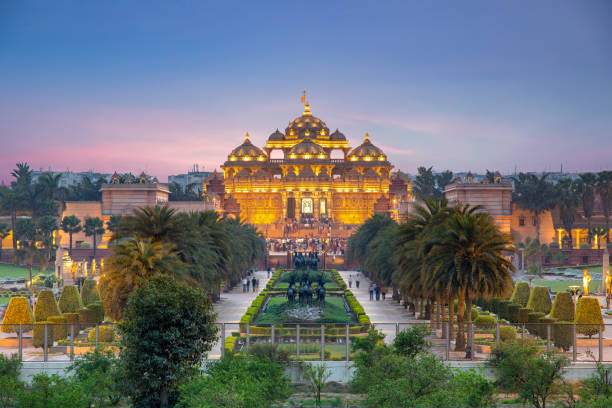Overview
The Golden Temple in Amritsar stands as a timeless symbol of Sikh spirituality, peace, and unity. It represents the essence of Sikh culture, devotion, and selfless service, drawing millions of visitors from across the world. The temple embodies humility and inclusiveness, welcoming people from all backgrounds to experience serenity and divine presence. Encircled by the sacred Amrit Sarovar, the temple offers an atmosphere of tranquility and spiritual enlightenment.
At the heart of the complex, the Golden Temple is adorned with intricate gold and marble craftsmanship. The sanctum is covered with 750 kg of gold, reflecting its spiritual grandeur. The structure features four entrances, symbolizing openness to all. The white marble parikrama (circumambulatory path) is adorned with floral motifs and inscriptions from the Guru Granth Sahib. Inside, the divine hymns of the Sikh scripture resonate throughout the day, filling the air with devotional bliss. The Akal Takht, the highest seat of Sikh authority, stands as a beacon of justice and faith, while the Langar (community kitchen) serves free meals to thousands daily, embodying the Sikh principle of seva (selfless service).
History
The Golden Temple, also known as Sri Harmandir Sahib, was founded by Guru Ram Das Ji, the fourth Sikh Guru, in 1581. The construction was completed in 1604 under the guidance of Guru Arjan Dev Ji, the fifth Sikh Guru, who also installed the Adi Granth (the first version of the Guru Granth Sahib) inside the sanctum.
Over the centuries, the temple has undergone several renovations. During the early 19th century, Maharaja Ranjit Singh covered the sanctum with 750 kg of gold, giving it its iconic golden appearance. Despite historical attacks, the temple has always been restored by the Sikh community, symbolizing resilience and devotion.
The Golden Temple remains one of the most revered spiritual and cultural sites in the world and serves as a symbol of Sikh faith, unity, and selfless service. It continues to attract millions of visitors and devotees each year.
Architecture
The Golden Temple is a stunning example of Sikh and Mughal architectural styles, blending intricate craftsmanship with spiritual symbolism:
- Sanctum: The inner shrine is covered with 750 kg of gold, giving the temple its iconic golden glow.
- Parikrama: The white marble circumambulatory path around the temple features floral motifs and inlaid semi-precious stones.
- Four Entrances: Symbolizing openness and inclusivity, the temple has entrances on all four sides, welcoming people of all faiths.
- Amrit Sarovar: The temple is surrounded by the sacred Amrit Sarovar (Pool of Nectar), where devotees take a holy dip.
- Akal Takht: Located within the complex, this elevated platform serves as the highest seat of Sikh temporal authority.
- Langar Hall: The temple houses one of the world’s largest community kitchens, feeding thousands of visitors daily as part of Sikh tradition.
Spiritual Significance
The Golden Temple, also known as Sri Harmandir Sahib, is the holiest shrine in Sikhism and a symbol of spiritual devotion and equality. It enshrines the teachings of the Guru Granth Sahib, the sacred scripture of Sikhism, which is continuously recited inside the sanctum.
The temple embodies the core Sikh values of seva (selfless service), humility, and unity. The name "Harmandir Sahib" means the "Temple of God," signifying that it is open to people of all faiths and backgrounds. A visit to the temple is believed to bring spiritual peace, purification of the soul, and divine blessings.
Visitor Attractions
Beyond the main temple, the Golden Temple complex offers several spiritual and cultural attractions:
- Amrit Sarovar: The sacred pool surrounding the temple, believed to have healing and purifying properties.
- Akal Takht: The highest seat of Sikh temporal authority, representing justice and spiritual guidance.
- Langar Hall: One of the world’s largest community kitchens, serving free meals to thousands daily, promoting equality and selfless service.
- Sikh Museum: Located within the complex, it showcases Sikh history, struggles, and contributions to society.
- Illuminated Night View: The temple is beautifully lit at night, reflecting on the Amrit Sarovar, creating a mesmerizing sight.
How to Reach
By Air: The nearest airport is Sri Guru Ram Dass Jee International Airport, about 13 km from the temple.
By Train: The closest railway station is Amritsar Junction, located around 2 km from the temple.
By Bus: Amritsar is well-connected by state and private buses. The nearest bus stand is Amritsar ISBT, about 3 km away.
By Car: The temple is easily accessible by road, with ample parking facilities available near the complex.
By Rickshaw/Auto: Auto-rickshaws and cycle rickshaws are a convenient way to reach the temple from different parts of the city.
Nearby Attractions
- Jallianwala Bagh (500 m)
- Durgiana Temple (2 km)
- Maharaja Ranjit Singh Museum (3 km)
- Partition Museum (1 km)
- Wagah Border (30 km)







